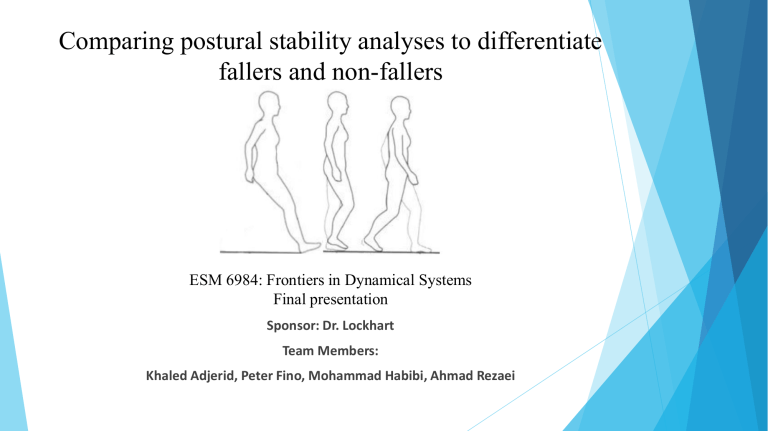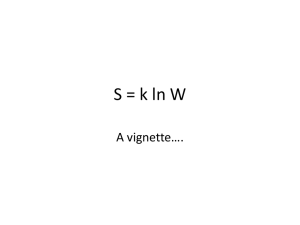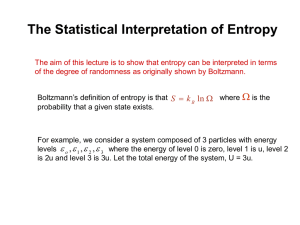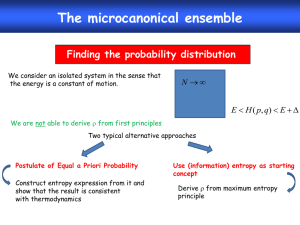Final presentation - Department of Engineering Science and

Comparing postural stability analyses to differentiate fallers and non-fallers
ESM 6984: Frontiers in Dynamical Systems
Final presentation
Sponsor: Dr. Lockhart
Team Members:
Khaled Adjerid, Peter Fino, Mohammad Habibi, Ahmad Rezaei
Fall risk assessment
The injuries due to fall and slip pose serious problems to human life.
Risk worsens with age
Hip fractures and slips
15,400 American deaths
$43.8 billion annually
Technical approach
How can we assess fall risk in the elderly?
Walking and balance is complex
Multiple mechanisms involved in slip and fall
Most assessment focused on age
Prediction of fall is still a big challenge in human factor science.
What data do we actually have?
60 second postural stability COP data
Eyes open
Eyes closed
41 fallers and 78 non-fallers
Fallers categorized by one or more falls in past 12 months
Average age: 76.3 ± 7.4
Time Series Analysis
Several methods have been developed for complexity and recurrence measures in time series:
Shannon entropy (ShanEn)
Renyi entropy (RenyEn)
Approximate entropy (ApEn)
Sample entropy (SaEn)
State Entropies
Multiscale entropy (MSE)
Composite multiscale entropy (CompMSE)
Recurrence quantification analysis (RQAEn)
Detrended fluctuation analysis (DFA)
Sequence Entropies
Input parameters were based of those used in throughout the literature for similar studies
Method
Renyi Entropy
Shannon Entropy
Approximate Entropy
Sample Entropy
Multi-Scale Entropy
Composite Multi-scale Entropy
Recurrence Quantification
Analysis Entropy
Acronym
RenyEn
ShanEn
ApEn
SaEn
MSE
CompMSE
RQAEn
Type of Entropy
State
State
Sequence
Sequence
Sequence
Sequence
Sequence
Complexity Index
-
-
-
-
Slope and Area
Input Parameters
α = 2 , M
α = 1, M r = 0.2 std, m = 3 r = 0.2 std, m =3 r = 0.2 std, m = 3, τ = 1,…,10
Slope and Area
r = 0.2 std, m = 3, τ = 1,…,10 m = 8, T = 6, ε =
0.30*mean
Prior to analyzing, data was converted from
2D to 1D time series
The Following Decision making process was adopted to test sensitivity (α=0.05) of methods
COP Data eyes closed vs eyes open
Significant difference
Not significant difference, throw out method
Sensitivity to differences between method
Comparison to prediction vs actual falls
Comparison to previous methods
Eyes open vs
Eyes close
Method
ApEn
SaEn
CompMSE
MSE
RQAEn
ShanEn
RenyEn
Measure
Angle
Radius
Angle
Radius
Angle Slope
Angle Area
Radius Area
Radius Slope
Angle Area
Angle Slope
Radius Area
Radius Slope
Angle
Radius
Entropy
Entropy
Status
Fallers vs non-fallers
Method
ApEn
SaEn
CompMSE
MSE
RQAEn
ShanEn
RenyEn
Measure
Angle
Radius
Angle
Radius
Angle Slope
Angle Area
Radius Area
Radius Slope
Angle Area
Angle Slope
Radius Area
Radius Slope
Angle
Radius
Entropy
Entropy
Status
Conclusion
ShaEn could not detect eyes open and eyes close.
SampEn, MSE and CompMSE could detect fallers and non-fallers.
We showed increase in complexity among fallers
Costa et al 2007 showed decrease in complexity among fallers
Ramdani et al 2013 found a difference between fallers and nonfallers using RQAEn.
We used radius and angle but previous studies used x and y coordinates.
Previous studies had limited sample size (14 fallers) while in our study we had robust sample size (41 fallers and 78 non-fallers)
We recommend MSE and CompMSE for postural entropy analysis.
Future works
Statistical significance between certain groups within each method
Obese vs normal BMI
Medications
Repeatability of each method with different data sets
QUESTIONS?
References
1.
Maki, B.E., P.J. Holliday, and A.K. Topper, A prospective study of postural balance and risk of falling in an ambulatory and independent elderly population.
Journal of
Gerontology, 1994. 49 (2): p. M72-M84.
2.
3.
Bergland, A., G.-B. Jarnlo, and K. Laake,
Boulgarides, L.K., et al.,
Predictors of falls in the elderly by location.
Aging clinical and experimental research, 2003.
Use of clinical and impairment-based tests to predict falls by community-dwelling older adults.
15 (1): p. 43-50.
Physical Therapy, 2003. 83 (4): p. 328-339.
4.
1272.
Norris, J.A., et al., Ability of static and statistical mechanics posturographic measures to distinguish between age and fall risk.
Journal of biomechanics, 2005. 38 (6): p. 1263-
5.
Thapa, P.B., et al., Clinical and biomechanical measures of balance fall predictors in ambulatory nursing home residents.
The Journals of Gerontology Series A: Biological
Sciences and Medical Sciences, 1996. 51 (5): p. M239-M246.
6.
Pajala, S., et al., Force platform balance measures as predictors of indoor and outdoor falls in community-dwelling women aged 63–76 years.
The Journals of Gerontology
Series A: Biological Sciences and Medical Sciences, 2008. 63 (2): p. 171-178.
7.
8.
Piirtola, M. and P. Era, Force platform measurements as predictors of falls among older people–a review.
Borg, F.G. and G. Laxåback, Entropy of balance- some recent results.
Gerontology, 2006.
Journal of neuroengineering and rehabilitation, 2010. 7
52 (1): p. 1-16.
: p. 38-38.
9.
68008.
Costa, M., et al., Noise and poise: Enhancement of postural complexity in the elderly with a stochastic-resonance–based therapy.
EPL (Europhysics Letters), 2007. 77 (6): p.
10.
Ramdani, S., et al., Recurrence quantification analysis of human postural fluctuations in older fallers and non-fallers.
Annals of biomedical engineering, 2013. 41 (8): p.
1713-1725.
11.
12.
Gao, J., et al., Shannon and Renyi entropies to classify effects of mild traumatic brain injury on postural sway.
PloS One, 2011. 6 (9): p. e24446.
Shannon, C.E., A mathematical theory of communication.
ACM SIGMOBILE Mobile Computing and Communications Review, 2001. 5 (1): p. 3-55.
13.
Pincus, S.M., Approximate entropy as a measure of system complexity.
Proc Natl Acad Sci U S A, 1991. 88 (6): p. 2297-301.
14.
Richman, J.S. and J.R. Moorman, Physiological time-series analysis using approximate entropy and sample entropy.
Am J Physiol Heart Circ Physiol, 2000. 278 (6): p.
H2039-49.
References
22.
23.
24.
15.
Lake, D.E., et al., Sample entropy analysis of neonatal heart rate variability.
American Journal of Physiology-Regulatory, Integrative and Comparative Physiology, 2002.
283 (3): p. R789-R797.
16.
Costa, M., A.L. Goldberger, and C.-K. Peng, Multiscale entropy analysis of complex physiologic time series.
Physical review letters, 2002. 89 (6): p. 068102.
17.
978-992.
Liu, Q., et al., Adaptive computation of multiscale entropy and its application in EEG signals for monitoring depth of anesthesia during surgery.
Entropy, 2012. 14 (6): p.
18.
19.
Wu, S.-D., et al., Time Series Analysis Using Composite Multiscale Entropy.
Marwan, N., et al., Recurrence plots for the analysis of complex systems.
Entropy, 2013. 15 (3): p. 1069-1084.
Physics Reports, 2007. 438 (5): p. 237-329.
20.
973.
21.
Webber, C. and J.P. Zbilut, Dynamical assessment of physiological systems and states using recurrence plot strategies.
Journal of Applied Physiology, 1994. 76 (2): p. 965-
Rhea, C.K., et al., Noise and complexity in human postural control: Interpreting the different estimations of entropy.
PloS one, 2011. 6 (3): p. e17696.
Lord, S.R. and H.B. Menz, Visual contributions to postural stability in older adults.
Gerontology, 2000. 46 (6): p. 306-310.
Chiari, L., L. Rocchi, and A. Cappello, Stabilometric parameters are affected by anthropometry and foot placement.
Clinical Biomechanics, 2002. 17 (9): p. 666-677.
Ihara, S., Information theory for continuous systems . Vol. 2. 1993: World Scientific.
25.
2004.
Bromiley, P., N. Thacker, and E. Bouhova-Thacker, Shannon entropy, Renyi entropy, and information.
Statistics and Inf. Series (2004-004), Available: www. tina-vision. net,
26.
Hasson, C.J., et al., Influence of embedding parameters and noise in center of pressure recurrence quantification analysis.
Gait & posture, 2008. 27 (3): p. 416-422.









